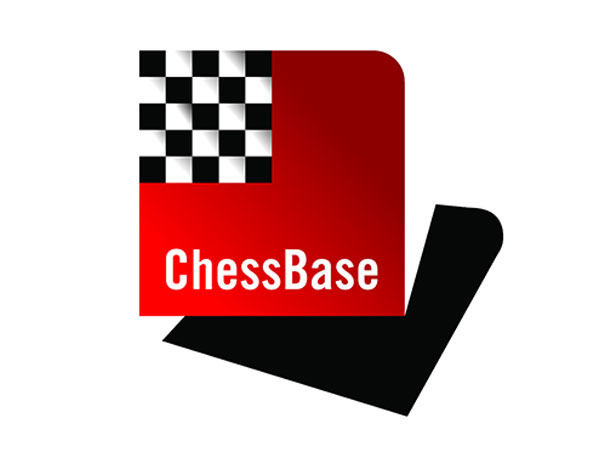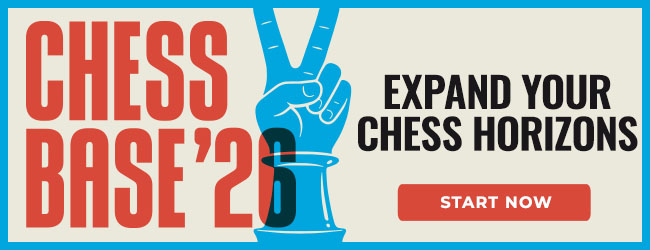It's the thought that counts
By Steve Giddins
Got a significant birthday coming up? Fancy something special as a present?
Yes, of course you do. What better than a work of art? £45 million would
recently have been enough for your relatives to secure a nice
little Titian, but if that kind of money is beyond their pocket, you may
struggle to get a conventional artwork of note. However, if you are a devotee
of endgame studies, the solution is easy – you just announce a composing
competition to mark your birthday, and then sit back and watch, as the world's
best study composers produce all manner of masterpieces, in your honour.
That is what Dutch endgame study guru, Harold van der Heijden (above) did last
year. His 50th birthday was marked by a composing event, and the winner was
the following spectacular effort, by the man many regard as the best study composer
currently active in the world:

[Event "1st Pr Harold van Der Heijden 50"]
[Site "?"]
[Date "2011.??.??"]
[Round "?"]
[White "Pervakov, O."]
[Black "White to play and win"]
[Result "1-0"]
[Annotator "Doe,John"]
[SetUp "1"]
[FEN "8/8/7r/2rk4/1K2R3/8/p4R2/2B3N1 w - - 0 1"]
[PlyCount "17"]
[EventDate "2012.??.??"]
{White has two extra pieces, but he has two pieces attacked, and the black
a-pawn is about to queen.} 1. Rd4+ $3 ({The other sacrifice} 1. Re5+ $2 Kxe5 2.
Bxh6 {fails to} a1=Q 3. Bg7+ Ke4 4. Bxa1 Rc1 5. Rf4+ Ke3 {and although he has
two extra pieces, all of White'ss units are attacked, and he cannot avoid a
drawn ending with R+minor piece v rook. Note that} 6. Bd4+ Kxf4 7. Ne2+ {fails
to} Ke4) 1... Kxd4 2. Bb2+ Ke3 (2... Kd5 3. Rf5+ {wins easily}) 3. Rf3+ $1 ({
Again, the only check. The alternative} 3. Re2+ {fails after} Kd3 4. Kxc5 Rh5+
5. Kb4 a1=Q 6. Bxa1 Rb5+ 7. Kxb5 {stalemate! A nice mid-board stalemate. Once
again, make a note of this position - something similar recurs soon.}) 3... Ke4
4. Kxc5 a1=Q 5. Bxa1 Rc6+ $1 6. Kb5 $1 ({Now after} 6. Kxc6 {we would have an
echo of the previous stalemate - the only difference is that the two kings and
the white rook have each moved one square to the "north-east" - instead of
being on the f1-a6 diagonal, they are on the h1-a8 diagonal.}) 6... Rc1 $1 ({
Chasing the king by} 6... Rc5+ 7. Kb6 Rc6+ 8. Kb7 {comes to nothing, since now
the BK has access to d5, so a further rook check on c7 or b6 could just be
captured. Black would therefore have to play} Rc1 {which comes to the same
thing as the game.}) 7. Rf4+ Ke3 {Compare this diagram with that in the note
to 1.Re5+?. The only difference is that the white king is now on b5, instead
of b4. But that makes all the difference!} 8. Ra4 $1 {And this is why - with
the WK on b4, this would be illegal, of course.} Rxg1 9. Bd4+ {A magnificent
tour de force by Pervakov, and a pretty nice birthday present to receive,
don't you think?} 1-0
A pretty marvellous birthday present, I hope you'll agree? But certainly no
more than the recipient deserved, because Harold van der Heijden is to the world
of endgame studies what…. – well, I can hardly think of a suitable
analogy. Chess is about more than just 2800-rated grandmasters, or world champion
players; some amateurs succeed in making massive contributions to our game,
and Harold is one of the greatest examples. Having learnt chess from a schoolfriend,
when aged twelve, Harold soon became interested in studies and problems, and
at the age of 17, he started a regular column on the subject, in the in-house
magazine of the HMC Den Bosch chess club in Rosmalen, of which he is still a
member. At the same time, he started collecting endgame studies featuring under-promotion.
"I have a dream…"
The introduction of the home computer, around 1980, was a major step forward.
Harold soon started writing a program to store chess positions, and made what
he now describes as "a few primitive attempts" to computerise his
card-index of under-promotion studies. But the real breakthrough came on 15
October 1988, at the inaugural meeting of ARVES,
the Dutch-Flemish endgame study society. One of the founders, Bas de Heer, gave
a lecture on the idea of a computer database of endgame studies. It was still
little more than a gleam in the lecturer's eye, a fantasy of the future. Except
for Harold, that is. To him, it served a rallying call, and on the very next
morning, he started working on building exactly such a database.
For the next 15 years, he worked an average of three to four hours per day
on his database, by which time he had assembled a collection of some 45,000
studies. Since then, other commitments have reduced his time to a "mere"
two hours a day, but he continues to expand his database. Version IV, released
last year, contains 76,132 studies.
To some readers, accustomed to multi-million game chess databases, such as
Megabase, this may not sound like a lot, but let us put it in perspective. If
you were to play through each and every study in the database, taking an average
of just five minutes on each one, and spending eight hours every day doing so,
it would still take you approximately 800 days to go through the entire database.
And Harold's database is much more than simply a collection of studies. Every
study has detailed publication sources, and has been checked, using the latest
chess software. Literally thousands and thousands of cooks, busts, anticipations
and other undesirable elements have been identified and noted. Numerous incorrect
studies have been corrected, source queries clarified, etc.
The task of bringing together such a collection has been a mammoth one. A great
many chess problems and endgame studies have not been published in specialist
chess magazines, but in mainstream newspapers, in numerous languages, in all
corners of the world. Harold and others have estimated that approximately 90,000
endgame studies have been published, so Harold's database contains roughly 85%
of all the endgame studies in existence! Of course, over the years, many others
have assisted, by sending material to Harold, and the process continues, but
it is still Harold to whom the overwhelming bulk of the credit goes, for this
remarkable resource. For judges of endgame study composing tourneys, his database
is simply indispensable, especially for seeking anticipations, that bane of
every composer's life.
So, of the 76,142 studies in his database, which is Harold's favourite? When
I asked him, he named two – the Saavedra study ("Nice to explain
to youngsters and study newbies") and the following classic by Mitrofanov,
often referred to amongst study enthusiasts as "the Qg5 study":

[Event "1.p Rustaveli MT Vecherni Tbilisi {c}"]
[Site "?"]
[Date "1967.??.??"]
[Round "?"]
[White "Mitrofanov, L."]
[Black "White to play and win"]
[Result "1-0"]
[SetUp "1"]
[FEN "8/k7/P2b2P1/KP1Pn2P/4R3/8/6np/8 w - - 0 1"]
[PlyCount "23"]
[EventDate "1967.??.??"]
1. b6+ Ka8 $1 2. Re1 $1 Nxe1 3. g7 h1=Q (3... Nc4+ 4. Kb5 h1=Q 5. g8=Q+ Bb8 6.
a7 Na3+ 7. Kc6 Qh2 8. axb8=Q+ Qxb8 9. b7+ Ka7 10. Qg1+ Ka6 11. Qb6#) 4. g8=Q+
Bb8 5. a7 Nc6+ $1 6. dxc6 Qxh5+ 7. Qg5 $3 Qxg5+ 8. Ka6 Bxa7 9. c7 Qa5+ 10. Kxa5
Kb7 11. bxa7 Kxa7 12. c8=Q 1-0
Of course, the work of compiling such a database is enough to occupy anybody
for life, isn't it? There is no way that Harold could manage anything else.
Er, except that he has. Happily married to his school sweetheart Dorette, Harold
has two sons, aged 22 and 19. He graduated in biochemistry, and has worked for
30 years as a research scientist at a veterinary institute in The Netherlands.
In 2009, he received his doctorate from the veterinary faculty of Utrecht University.
He has also taught himself Russian in his spare time ("What spare time??",
I hear you ask…), has written three books on study-related topics, was
for 13 years the editor of EBUR, the endgame study magazine of ARVES, and since
2007, has been editor of EG, the world's principal (only?) endgame study magazine.
Oh yes, and he also finds time to compose studies himself. He confessed that
it was hard to select his best work, but he likes the following one, which is
bound up with a rather interesting story, concerning Russian GM and trainer,
Artur Yusupov. More of that in a few days' time, when we present the solution;
for now, have a go at solving the study – the first move is a delightful
surprise:
Harold van der Heijden

White to play and win

|
- The world's largest collection of endgame studies
- 76,132 endgame studies
- PGN-format
- Price: 50 EUR (Discount for recent buyers of HHdbIII)
- More than 8000 new studies, and tens of thousands corrections in
other studies
Numerous extra endgame study details added.
The product consists of a chess database in PGN-format, without any
software. In order to access the database you need to have chess software.
|
Copyright
ChessBase
























